Please scroll to the bottom of the page for the English version.
12月中旬から執筆している創業285年「誉田屋源兵衛」十代目山口源兵衛さんへのインタビュー第一弾、二弾に引き続き、今回の第三弾では源兵衛さんのインタビュー後に見せていただた「誉田屋源兵衛」の国宝レベルの奇跡の帯たちにフォーカスしてご紹介していきます。
源兵衛さんは国内外に熱狂的信奉者がいらっしゃり、代々受け継がれてきた技術と伝統を引き継ぎながら、着物業界に「革新」を起こすような作品を次々と発表されています。まさに「帯業界の異端児」です!
「誉田屋源兵衛」オフィシャルウェブサイトはこちら。 https://kondayagenbei.jp
私が源兵衛さんのことを知ったのは、パートナージョセフが源兵衛さんの帯の動画をYoutubeで見つけたのがきっかけです。その動画で紹介されていたこちらの漆黒の生地にラピスラズリを使用して、大胆に牡丹が織り込まれた帯を見た瞬間に虜になりました。
去年の11月の帰国時に様々な奇跡が重なり、京都で源兵衛さんに直接お会いしてインタビューをさせていただく機会に恵まれました。
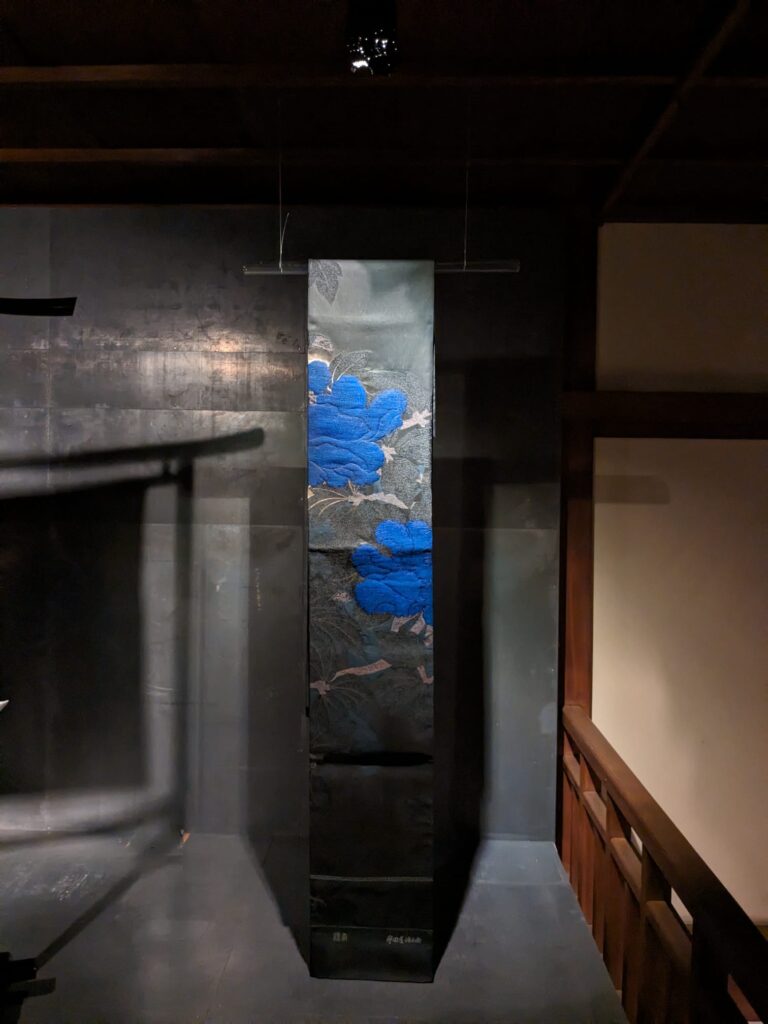
第一弾 源兵衛さんインタビュー記事→ https://ayakanoikigaidou.com/post-5026/
「教科書には載っていない日本の歴史」「物事を複雑化しすぎる現代人」「観光地ではない本当の京都と日本の文化」
第二弾 源兵衛さんインタビュー記事
→ https://ayakanoikigaidou.com/post-5241/
「源兵衛さん自身のお寺での修行のお話」「親友 田中泯さんとの出会い」「源兵衛さんの意外なご趣味」
それでは実際に見せていただいた「誉田屋源兵衛」の想像を絶するほど美しい、計り知れないほど希少価値の高い帯たちを詳しくご紹介していきます。「誉田屋源兵衛」の堀田さんが一つ一つの帯を非常に丁寧に解説してくださいました。心から感謝いたします。
- 柿渋を使って20〜30回繰り返し染められた帯
- 孔雀の羽を積むように織って作られた帯
- 貝殻を使用して、超人的な繊細な技法で作られた帯
- プラチナで伊藤若冲の作品を表現した帯
- 引き続き、第四弾では「誉田屋源兵衛」で見せていただいた奇跡の帯たちの詳細をご紹介していきます!
- The unimaginable miraculous obi of “Kondaya Genbei,” founded 285 years ago Obi Manufacturing and Sales Company in Kyoto
- An obi dyed by repeating the process 20 to 30 times using persimmon tannin
- Obi woven and crafted by incorporating peacock feathers
- Obi Made with Seashells Using Superhumanly Delicate Techniques
- Obi Expressing the Art of Ito Jakuchu Using Platinum
- Continuing with the fourth installment, I will now provide detailed introductions to the miraculous obi shown to us at ‘Kondaya Genbei.’ Stay tuned for more insights into these extraordinary pieces!
柿渋を使って20〜30回繰り返し染められた帯

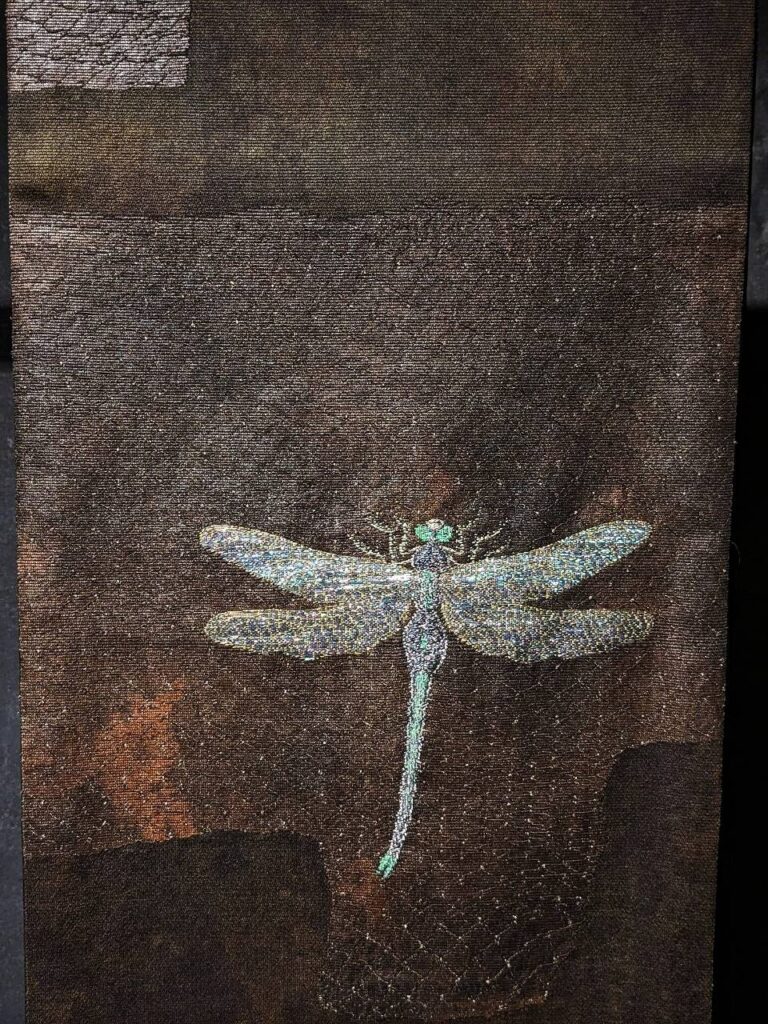
こちらの帯は、柿渋で染めたミツマタの和紙を裁断して糸にして織り上げられています。さらにここまでの深い色を出すために、染めと干しの工程を20〜30回繰り返しています。
柿渋が材料であることから、こちらの帯は歳月とともに色を変えていきます。100年後のこちらの帯を見るとまた表情が変わっていることでしょう。またトンボのシルバーの部分はプラチナが使用されています。
孔雀の羽を積むように織って作られた帯

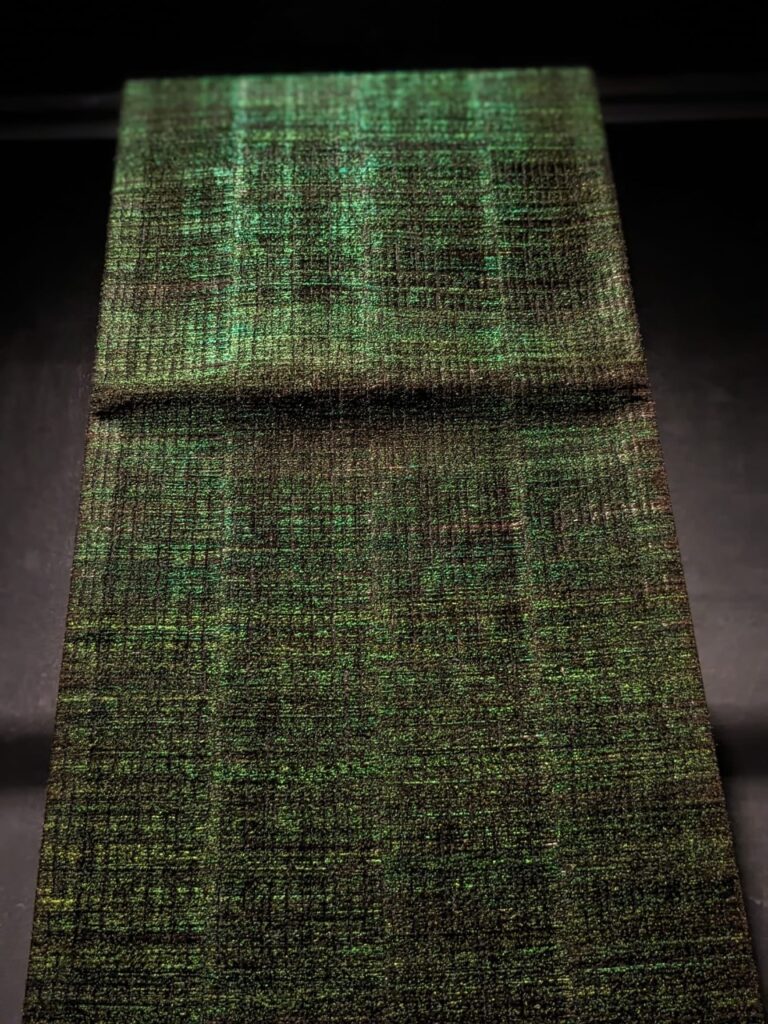
孔雀の羽を経糸の中に積むようにして織られた帯です。孔雀の羽は鼻息で飛ぶくらいふわふわで軽いので、気の遠くなるような繊細で細かいお仕事であることが分かります。
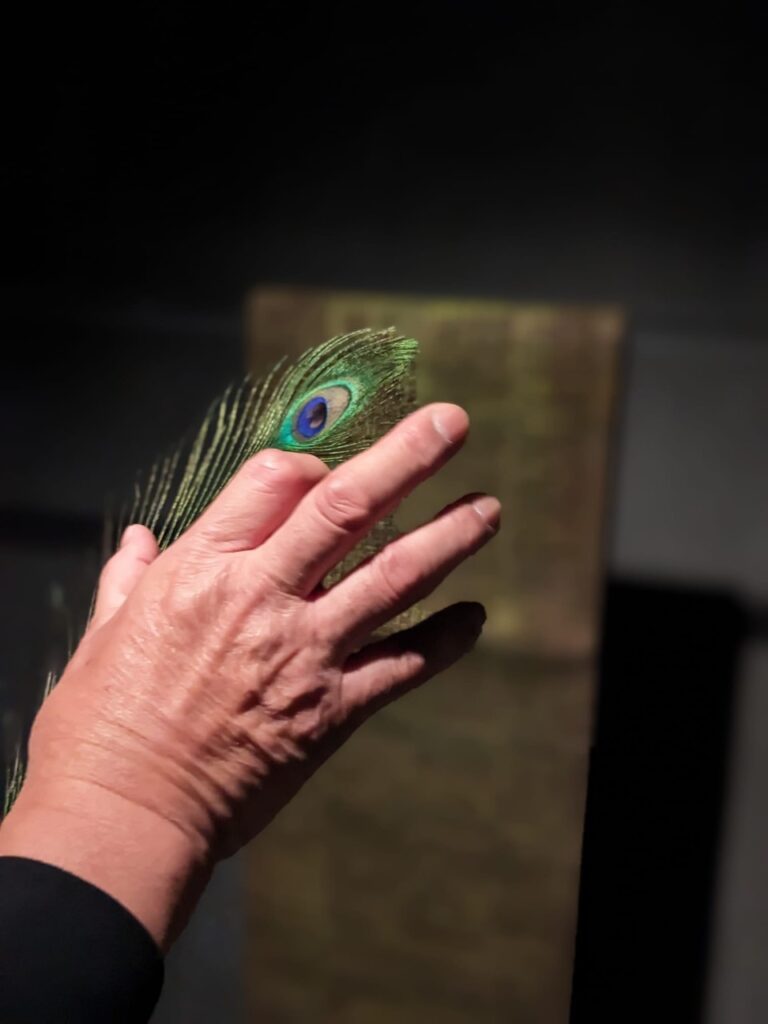
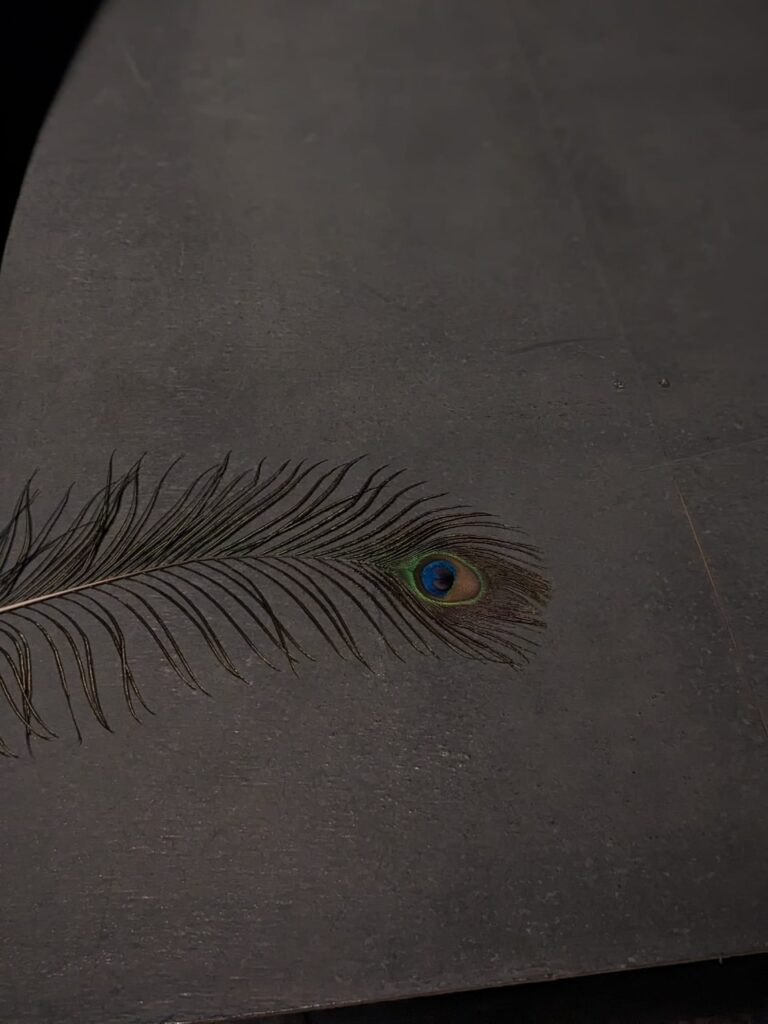
こちらの帯の大きな特徴は見る角度によって色が変わることです。
1枚目と2枚目の写真では美しい緑色がメインで見えていますよね。しかし下の2枚の写真では焦げ茶色がメインで、緑が少しだけ垣間見えるようなバランスで見えます。
この帯を結んだら、どんな見え方になるのか想像を掻き立てられます。結ぶことで立体的になり緑と焦げ茶のグラデーションが美しく表現されるに違いありません。また帯結びの種類によっても大きく見え方が変わることでしょう。


歴史を遡ると上杉謙信がこちらの織物で陣羽織を作っていたという事実があるそうです。つまりこの技法は新しく創造したわけではなく、約450年前の復元ということ。しかし上杉謙信の時代からは誰もこの技法で織物を作っておらず、もし源兵衛さんが復元しなかったら、永遠に見ることは出来なかったわけです。
今現在この技術を持った職人はもういらっしゃらず、復元出来ないそうです。
貝殻を使用して、超人的な繊細な技法で作られた帯
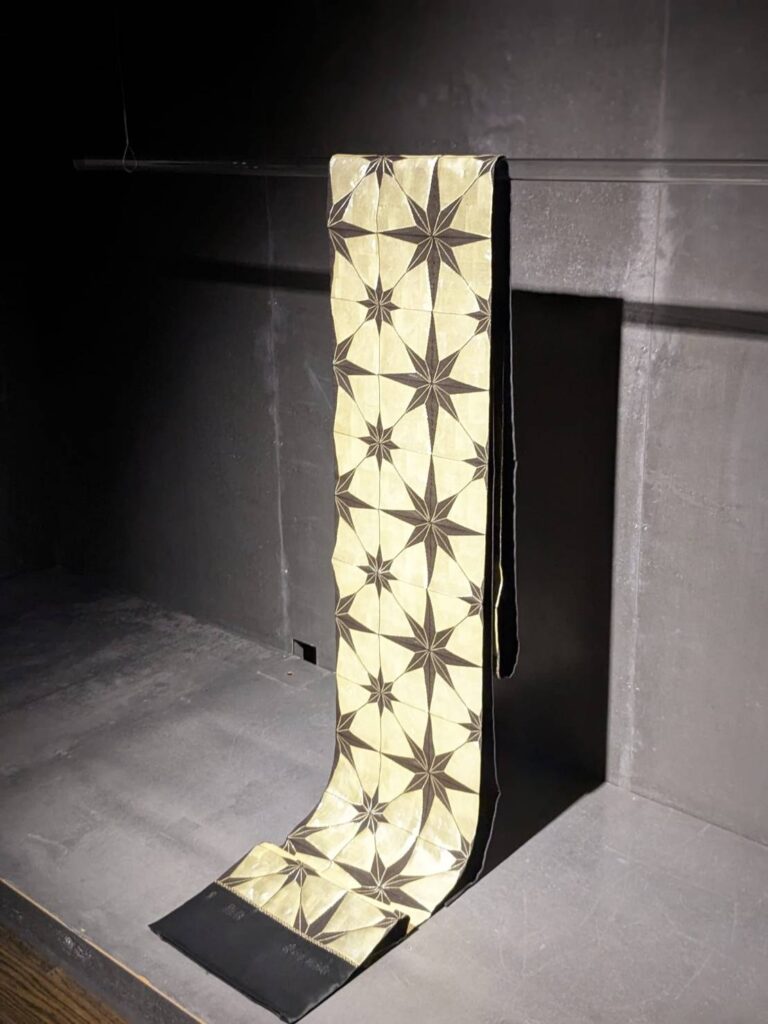
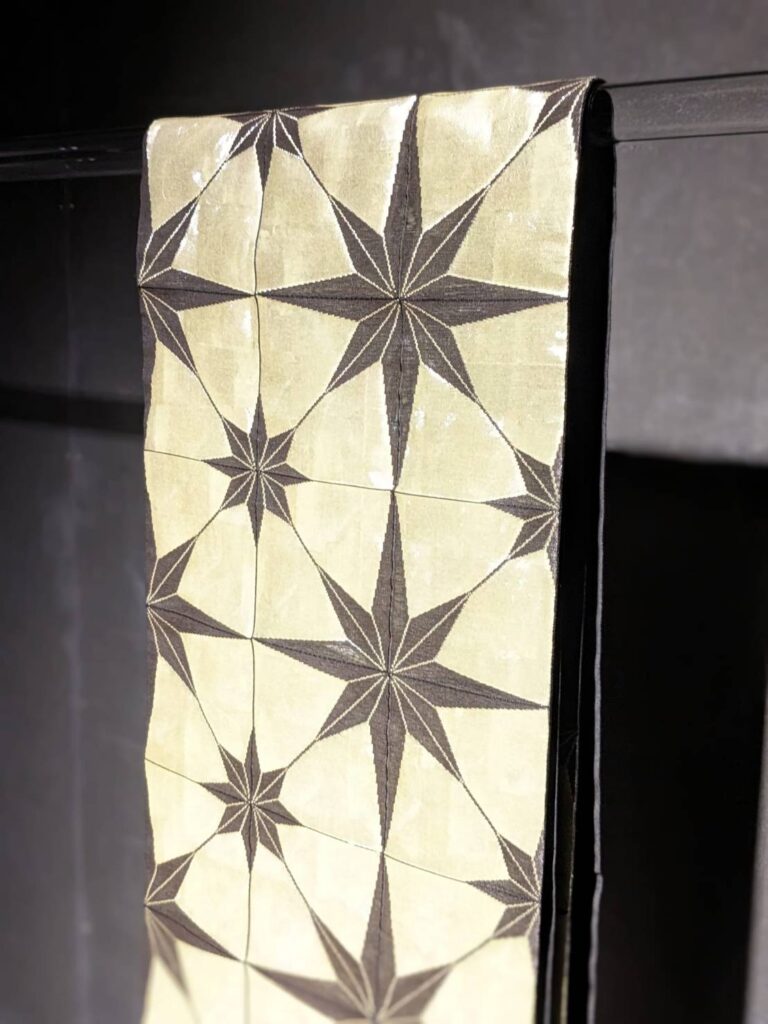
こちらの帯は貝殻を使用して作られた帯です。
具体的な制作方法は、まず貝殻を半分に切ります。穴が空いているような傷んでいるところは使えないので、綺麗な貝殻の箇所だけを使用。そして両面から研磨してあらわれる内側の綺麗な部分だけを磨きとります。物差しでは計測不能なレベルの薄さのシート状のものを作り出し、それらを数限りなく揃えて和紙に貼って、バラバラにならないようにコーティングします。
そのシートをさらに極細の糸状に裁断。そうしてやっと織り始めることができます。
貝殻にも光の柄があるため、それをまた復元するためにピチッと柄を合わせながらしながら織っていくそうです。
こちらの貝殻でできた帯を特別に触らせていただきました。堅い貝殻でできたことが信じられないほど滑らかで柔らかいことに驚きました。
普通堅いものはいくら薄くしても割れますよね。実はこの帯には目に見えない割れ目が全部入っているそう。すでに割れているから割れないんです。割れ目すら見えないように割れているんです。
柔らかく仕上げる究極の技法。その割れ目すら見えない究極の薄さに仕上げています。それ以上の厚さだ割れ目が破れて穴が空いているように見えてしまうそうです。
歴史を辿ると、過去に貝殻を使った帯があったそうですが、「誉田屋源兵衛」で作られた超人的な極薄ではなかったとか。そのため割れて見栄えが悪くなるので、帯の折れ目のかからないところに少し入れていた程度だったそうです。しかしそれは源兵衛さんにとったらNG。「帯として機能しないと意味がない」というのが源兵衛さんの考え方です。
また「紫式部日記」によると歴史上ではお姫様たちが貝を貼っていた程度。こんな貝殻の使い方をしたのは日本歴史上源兵衛さんが初めてということです。
プラチナで伊藤若冲の作品を表現した帯

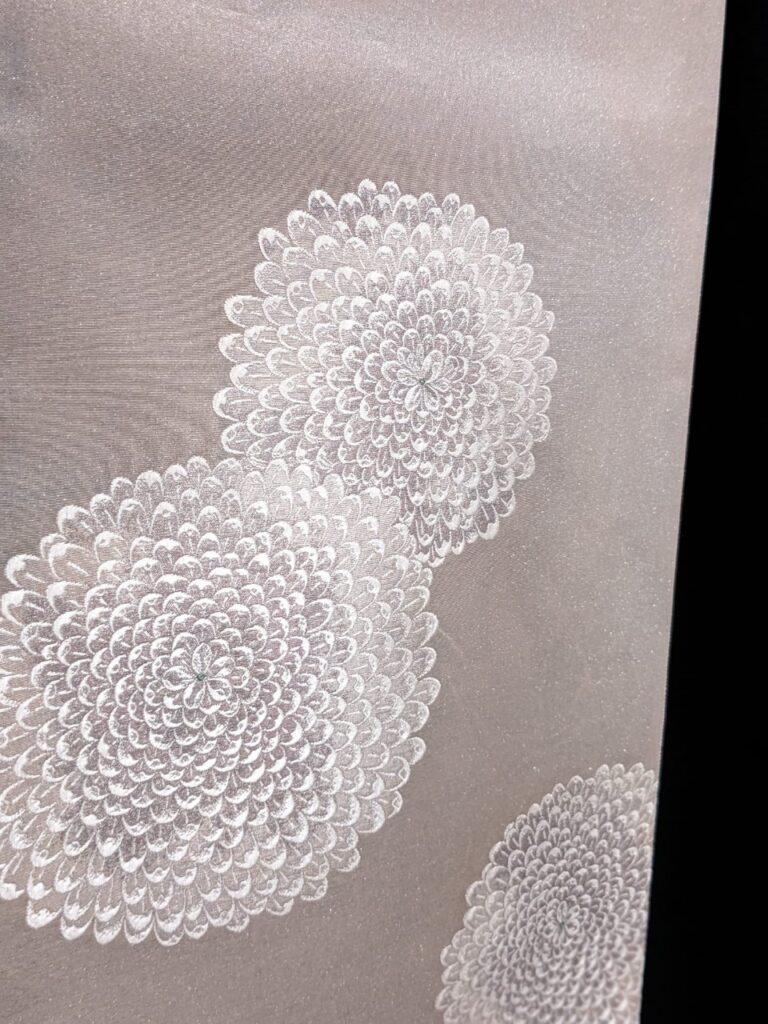
プラチナで伊藤若冲の作品を表現した帯もありました。各工程の名人たちが試行錯誤しながらなんと制作期間10年間!伊藤若冲の作品の無重力感を織物でどれだけ表現できるかの挑戦だったそう。
この白い部分にプラチナが使用されていて、見る角度を変えるとさらにプラチナの金属の風合いがわかりました。
具体的な制作工程は、ミツマタの日本最高級の和紙に漆を塗ることで、漆が接着剤の働きをします。その上に吹けば飛ぶくらい薄く伸ばしたプラチナを貼っていき、そのシートをまた細かく裁断して糸を作り、それらを一本ずつ織って制作されています。
それと同時に極細の糸で柄も織り込んでいきます。驚いたことにこの柄は刺繍ではなく、織物で表現されているわけです。だから透明感があって無重力感を表現できている。
この風合いを出すのが超人レベルの匠の技なんです。
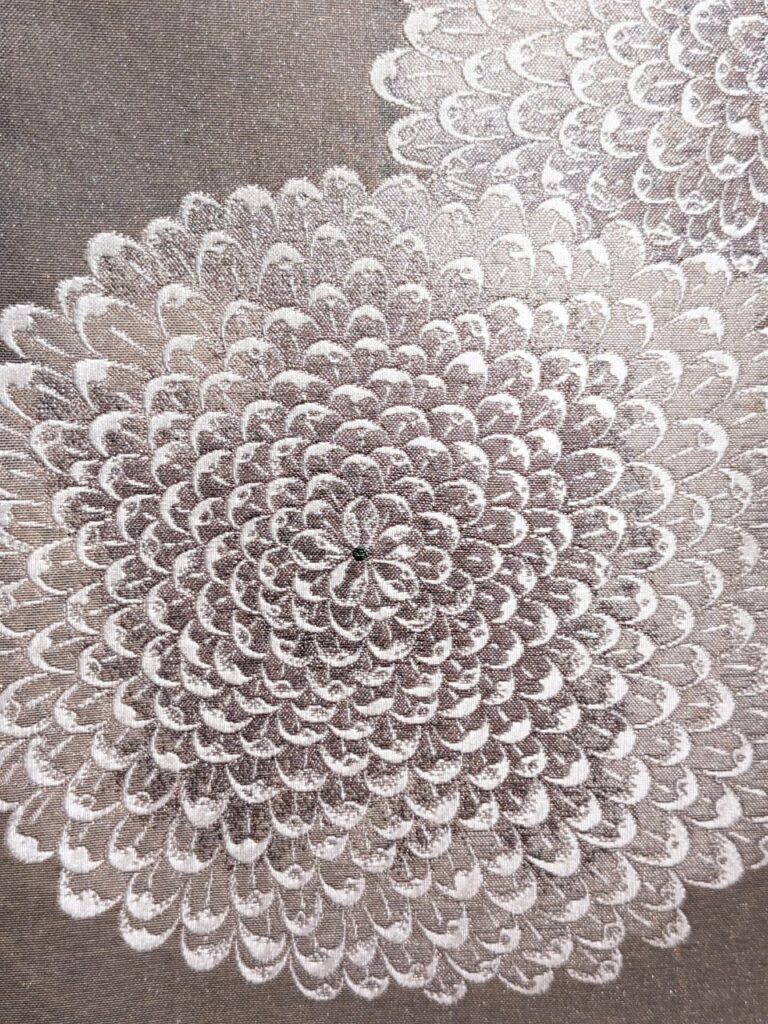
織物はたいてい「ボリュームを出す」という概念で作られていきます。しかしこの帯の凄さは「ボリュームを消す」という真逆のことに挑戦したというところです。
どういった着物に合わせるのか想像するだけでワクワクします。
引き続き、第四弾では「誉田屋源兵衛」で見せていただいた奇跡の帯たちの詳細をご紹介していきます!
実は今回の第三弾が「誉田屋源兵衛」シリーズの最終章になるだろうと思っていましたが、想像以上に「誉田屋源兵衛」の帯の一本一本が奥深く興味深い情報量が多いことを執筆しながら痛感し、第四弾と分けてご紹介してきます。
この記事を読んでいただいた日本人の方が自国の文化に誇りを持ち、深く理解するきっかけになりますように。そして自国を愛する心が深まりますように。
海外の方が、日本の文化に興味を持ち、真の魅力と奥深さの虜になるきっかけになりますように。
そしてそれらが、失いつつある日本の美しい文化を守る小さな力添えに繋がりますように。
私がバンクーバーに住み始めて約2年が経ちます。日本を離れたからこそ強く感じる日本の価値と深い魅力。伝統美、趣の深さ。それを少しでも多くの方に伝えることが私が愛する母国のためにできることだと考えています。
一人一人の母国を愛する力は、必ず日本を明るい未来に導きます。
第四弾も近日中に執筆しますので、是非ご一読ください!
Please scroll to the bottom of the page for the English version.
The unimaginable miraculous obi of “Kondaya Genbei,” founded 285 years ago Obi Manufacturing and Sales Company in Kyoto
Since mid-December, I have been working on the first and second installments of interviews with Mr. Yamaguchi Genbei, the tenth generation of the 285-year-old establishment “Kondaya Genbei.” In this third installment, we will focus on the beautiful obi (sashes) from “Kondaya Genbei” that were shown to us after the interview with Mr. Genbei.
Mr. Genbei has enthusiastic followers both domestically and internationally. While inheriting the skills and traditions passed down through generations, he continues to unveil works that bring about “innovation” in the world of kimono, truly earning the title of the “maverick of the obi industry!”
The official website of “Kondaya Genbei” can be found here: https://kondayagenbei.jp
I first learned about Mr. Genbei when my partner discovered a video of his obi on Youtube. The moment I saw the bold peony woven into this jet-black fabric adorned with lapis lazuli, as showcased in that video, I was captivated.
Various miracles aligned during my return to Japan in November last year, providing me with the opportunity to meet Mr. Genbei in person in Kyoto and conduct an interview.
First Installment: Interview with Mr. Genbei Article → Link
“Unveiling Japan’s History Not Found in Textbooks,” “Modern Complications Faced by People,” “The Real Kyoto and Japanese Culture Beyond Tourist Spots.”
Second Installment: Interview with Mr. Genbei Article → Link
“Mr. Genbei’s Personal Stories of Training at His Own Temple,” “Encounter with Close Friend Mr. Min Tanaka,” “Surprising Hobbies of Mr. Genbei.”
Now, let’s delve into the unimaginably beautiful and immeasurably rare obi from “Kondaya Genbei” that were shown to us. Mr. Hotta from “Konadaya Genbei” graciously provided detailed explanations for each obi. I sincerely express my gratitude.
An obi dyed by repeating the process 20 to 30 times using persimmon tannin
“This obi is woven from threads cut from paper mulberry (mitsumata) dyed with persimmon tannin. To achieve the deep color seen here, the dyeing and drying process is repeated 20 to 30 times.
Due to the use of persimmon tannin in this obi, its color will change over time, evolving with the years. When one looks at this obi a hundred years from now, its expression is likely to have transformed. The silver dragonfly motif is crafted with platinum.
Obi woven and crafted by incorporating peacock feathers
This is an obi woven by incorporating peacock feathers into the warp threads. The peacock feathers are so soft and lightweight, almost floating with a breath, indicating the meticulous and delicate craftsmanship involved in creating this intricate piece of work..
One notable feature of this obi is its ability to change color depending on the viewing angle. In the first and second photos, a beautiful green hue dominates. However, in the lower two photos, a rich brown color takes the lead, with hints of green peeping through.
Imagining how this obi will appear when tied is truly captivating. The three-dimensional effect created by tying it will undoubtedly showcase a beautiful gradient of green and brown! Moreover, the way it is tied can significantly alter its overall appearance.
Historically, it is known that Uesugi Kenshin created Jinbaori (warrior vest) using this weaving technique. Therefore, this method is not a recent innovation but rather a restoration dating back approximately 450 years. However, since Uesugi Kenshin’s era, no one has been using this technique for weaving until Mr. Genbei revived it. Without his efforts, we might never have had the chance to witness this ancient craft again.
Currently, there are no artisans possessing this technique, and it is said that it cannot be restored.
Obi Made with Seashells Using Superhumanly Delicate Techniques
This obi is made using seashells.
The specific production method involves first cutting the seashells in half. Only the pristine parts of the shells are used, as damaged areas with holes are not suitable. The beautiful inner sections revealed by polishing both sides are carefully polished further.
From there, sheets are created at an immeasurable thickness level using a ruler, and these sheets are aligned in countless layers, adhered to Japanese paper, and coated to prevent them from coming apart. The sheets are then finely cut into thread-like strands, and only then can the weaving process begin.
Because seashells exhibit patterns in light, the weaver meticulously aligns these patterns during the weaving process to restore their original appearance.
I had the privilege of touching a special obi made from these seashells. Despite being made from firm shells, it was astonishingly smooth and soft.
Ordinarily, even thin and hard materials are prone to breaking. Surprisingly, this obi has invisible fractures throughout. The reason it doesn’t break further is because it’s already broken.
It is finished to the ultimate thinness where even the seams are invisible. It is said that any thickness beyond that, the seams would appear torn, giving the appearance of holes.
When tracing back through history, there were belts made with seashells in the past, but they were not as superhumanly thin as those created by ‘Kondata-ya Genbei.’ To avoid the unsightly appearance caused by fractures, they were discreetly placed in areas of the obi that wouldn’t be visible during wear.
However, this approach didn’t align with Mr. Genbei’s philosophy, as he believes an obi should serve its functional purpose. According to historical records such as “Murasaki Shikibu Nikki,” princesses in the past adorned themselves with shells, but Mr. Genbei is credited with being the first in Japanese history to use seashells in such a groundbreaking way.
Obi Expressing the Art of Ito Jakuchu Using Platinum
There is also an obi that expresses the works of Ito Jakuchu using platinum. Various master craftsmen dedicated an astonishing 10 years to the creation of this piece, experimenting and challenging themselves to capture the weightless quality found in Ito Jakuchu’s artwork through weaving.
Platinum is used in the white portions of the obi, and depending on the viewing angle, the metallic brilliance of platinum becomes apparent. The specific production process involves applying lacquer to Mitsu-mata, Japan’s finest handmade paper, with the lacquer acting as an adhesive. Thinly stretched platinum is delicately applied over it, forming sheets that are finely cut into threads.
These threads are then woven one by one to create the obi. Simultaneously, intricate patterns are woven with ultra-fine threads. Surprisingly, these patterns are not embroidered but expressed with extremely fine woven threads, contributing to the transparent and weightless quality of the design. Achieving this texture requires the extraordinary skills of a master craftsman.
Most woven fabrics are created with the concept of “adding volume.” However, the remarkable aspect of this obi lies in its challenge to do the exact opposite – to “reduce volume.” Imagining how it will complement various kimono ensembles is an exciting prospect in itself.
Continuing with the fourth installment, I will now provide detailed introductions to the miraculous obi shown to us at ‘Kondaya Genbei.’ Stay tuned for more insights into these extraordinary pieces!
I initially thought that the third installment of the ‘Kondaya Genbei’ series would be the final chapter. However, as I wrote, I realized that each obi from ‘Kondaya Genbei’ contains an unexpectedly deep and fascinating wealth of information. Therefore, I’ve decided to separate and introduce them in the fourth installment.
I hope that this article serves as an opportunity for Japanese readers to take pride in and deepen their understanding of their own culture. May it nurture a stronger love for their country.
For international readers, I hope it sparks an interest in Japanese culture and captivates them with its true charm and depth. Furthermore, I wish that these insights contribute in a small way to preserving the beauty of Japan’s vanishing traditions.
Having lived in Vancouver for about two years now, I’ve come to appreciate the value and profound charm of Japan, especially since being away. The beauty of tradition and its deep allure. I believe that conveying these aspects to as many people as possible is something I can do for my beloved homeland.
The individual strength to love one’s homeland will undoubtedly guide Japan towards a brighter future. Stay tuned for the fourth installment, which I’ll be writing soon. Please give it a read!


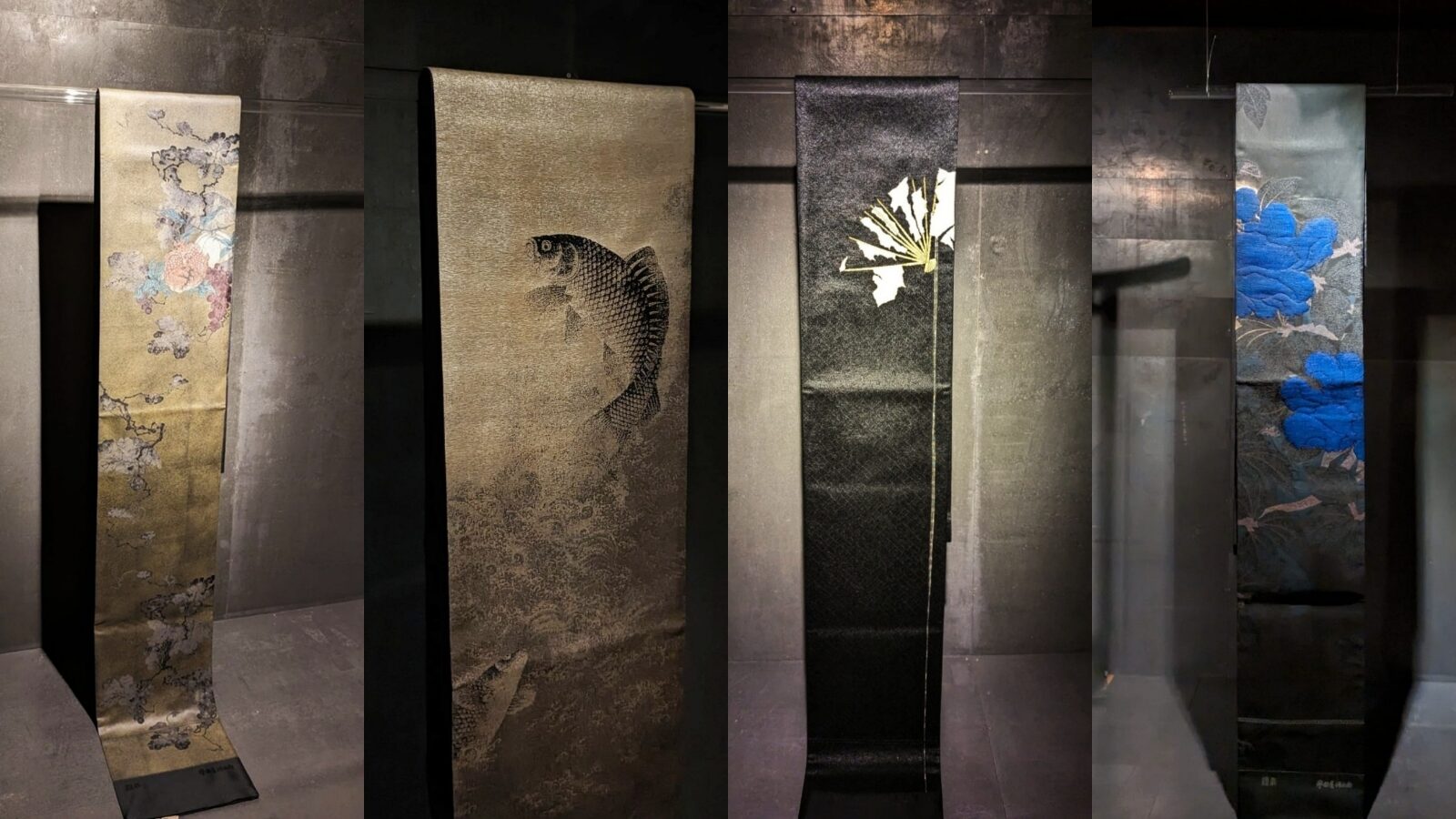
コメント